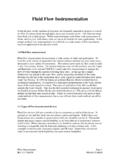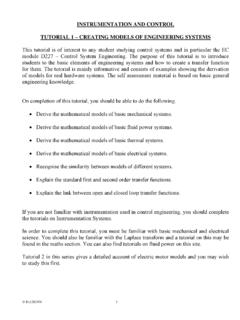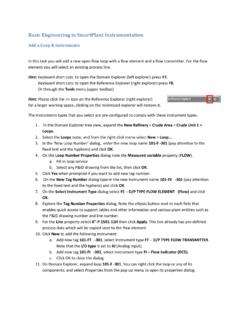Transcription of TUTORIAL 7 – STABILITY ANALYSIS
1 TUTORIAL 7 STABILITY ANALYSIS . This TUTORIAL is specifically written for students studying the EC module D227 Control System Engineering but is also useful for any student studying control. On completion of this TUTORIAL , you should be able to do the following. Explain the basic definition of system instability. Explain and plot Nyquist diagrams. Explain and calculate gain and phase margins. Explain and produce Bode plots. The next TUTORIAL continues the study of STABILITY . If you are not familiar with instrumentation used in control engineering, you should complete the tutorials on Instrumentation Systems. In order to complete the theoretical part of this TUTORIAL , you must be familiar with basic mechanical and electrical science.
2 You must also be familiar with the use of transfer functions and the Laplace Transform (see maths tutorials ). 1. 1. INSTABILITY. Consider a system in which the signals are added instead of subtracted by the summer. This is positive feed back. The electronic amplifier shown is an example of this. Figure 1. We may derive the closed loop transfer function as follows. o G1 = o e = i + G 2 o G1 =. e i + G 2 o ( ). G1 i + G 2 o = o G1 i + G1G 2 o = o G1 i = o - G1G 2 o (. G1 i = o 1 G1G 2 ) G cl =. o i =. G1. 1 G1G 2. If G1 G2 = 1 then Gcl = and the system is unstable. If G1 G2 1 then Gcl has a finite value which is small or large depending on the values. In the electronic amplifier, the gain can be controlled by adjusting the feed back resistor (attenuator).
3 Suppose G1 = 1 and G2 = Gcl = 1/(1- ) = 5. Suppose G1 = 1 and G2 = Gcl = 1/(1- ) = 100. The closer the value of G2 is to 1 the higher the overall gain. It is essential that G2 is an attenuator if the system is not to be unstable. A system designed for negative feed back with a summer that subtracts should be stable but when the signals vary, such as with a sinusoidal signal, it is possible for them to become unstable. Consider an automatic control system such as the stabilisers on a ship. When the ship rolls, the stabilisers change angle to bring it back before the roll becomes uncomfortably large. If the stabilisers moved the wrong way, the ship would roll further. This should not happen with a well designed system but there are reasons and causes that can make such a thing happen.
4 Suppose the ship was rolling back and forth at its natural frequency. All ships should have a righting force when they roll because of the buoyancy and will roll at a natural frequency defined by the weight, size and distribution of mass and so on. The sensor detects the roll and the hydraulic system is activated to move the stabiliser fins. Suppose that the hydraulics move too slow (perhaps a leak in the line) and by the time the stabilisers have responded, the ship has already righted itself and started to roll the other way. The stabilisers will now be in the wrong position and will make the ship roll even further. The time delay has made matters worse instead of better and this is basically what instability is about.
5 Another example of positive feed back is when you place a microphone in front of a loud speaker and get a loud oscillation. Another example is when you push a child on swing. If you give a small push at the start of each swing, the swing will move higher and higher. You are adding energy to the system, the opposite affect of damping. If you stop pushing, friction will slowly bring it back to rest. With positive feedback, energy is added to the system making the output grow out of control. A system would not be designed with positive feedback but when a sinusoidal signal is applied, it is possible for the negative feedback to be converted into positive feedback. This occurs when the phase shift of the feedback is 180o to the input and the gain of the system is one or more.
6 When this happens, the feedback reinforces the error instead of reducing it. 2. 2. NYQUIST DIAGRAMS. A system with negative feed back becomes unstable if the signal arriving back at the summer is larger than the input signal and has shifted 180o relative to it. Consider the block diagram of the closed loop system. A sinusoidal signal is put in and the feed back is subtracted with the summer to produce the error. Due to time delay the feed back is 180o out of phase with the input. When they are summed the result is an error signal larger than the input signal. This will produce instability and the output will grow and grow. Figure 2. A method of checking if this is going to happen is to disconnect the feed back at the summer and measure the feed back over a wide range of frequencies.
7 Figure 3. If it is found that there is a frequency that produces a phase shift of 180o and there is a gain in the signal, then instability will result. The Nyquist diagram is the locus of the open loop transfer function plotted on the complex plane. If a system is inherently unstable, the Nyquist diagram will enclose the point -1 (the point where the phase angle is 180o and unity gain). Consider the following system. Figure 4. 3. The transfer function relating i and is G(s) G1 x G2 x G3 = K/{s(1+s)(1+2s)}. Converting this into a complex number (s = j ) we find G( j ) =. {. K 3 2 } . K( 2 3 ). {. 9 4 + ( 2 3 ) } j {. 9 4 + ( 2 3 ) }. The polar plot below (Nyquist Diagram) is shown for K = 1 and K = We can see that at the 180o position the radius is less than 1 when K = 1 so the system will be stable.
8 When K = 2 the radius is greater than 1 so the system is unstable. We conclude that turning up the gain makes the system become unstable. Figure 5. The plot will cross the real axis when = 2 3 or = and this is true for all frequencies. The plot will enclose the -1 point if {. K 3 2 } 1 so the limit is when K 3 2 = 9 4 + ( 2 3 ). {9 + ( 2 ). 4 3. }. Putting = the limiting value of K is ALTERNATIVE METHOD. There is another way to solve this and similar problems. The transfer function is broken down into separate components so in the above case we have: K 1 1. G(s) = x x Each is turned into polar co-ordinates (see previous TUTORIAL ). s (1 + s) (1 + 2s). K K. produces a radius of and an angle of - 90 o for all radii s . 1 1.
9 Produces a radius of and angle tan - 1 ( ). 1+ s 1+ 2. 1 1. produces a radius of and angle tan - 1 2 . 1 + 2s 1 + 4 2. When we multiply polar coordinates remember that the resultant radius is the product of the individual radii and the resultant angle is the sum of the individual angles. The polar coordinates of the transfer function are then: K 1 1. Radius is x x Angle is - 90 o tan -1 ( ) tan -1 2 . 1+ 2. 1 + 4 2. Put = Radius = x x = K Angle = -90 - - = -180o If K = the radius is 1 as stated previously. 4. 3 PHASE MARGIN and GAIN MARGIN. PHASE MARGIN. This is the additional phase lag which is needed to bring the system to the limit of STABILITY . In other words it is the angle between the point -1 and the vector of magnitude 1.
10 GAIN MARGIN. This is the additional gain required to bring the system to the limit of STABILITY . Figure 6. WORKED EXAMPLE The open loop transfer function of a system is G(s) = 200/{(1+2S)(3+S)(5+S)}. Produce a polar plot for = 3 to = 10. Determine the phase and gain margin. SOLUTION. Evaluate the polar coordinates for 200/(1 + 2s), then 1/(2+s) then 1/(5+s) (See previous TUTORIAL ). 5. Now add the three sets of angles and multiply the three sets of radii and plot the results. Figure 7. The region of interest is where the plot is -180o and the radius is 1. This would require a much more accurate plot around the region for = 3 to 5 as shown below. Figure 8. The phase margin is 180 166 = 14o The gain margin is 1 = SELF ASSESSMENT EXERCISE 1 Determine the steady state gain and primary time constant for G(s) = 10/(s + 5).
















